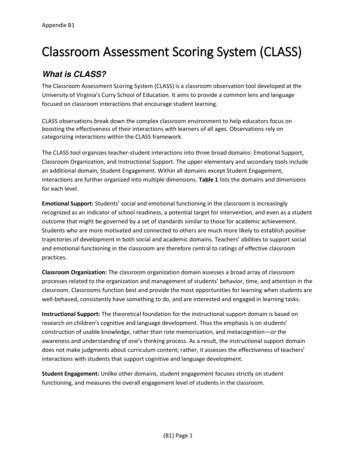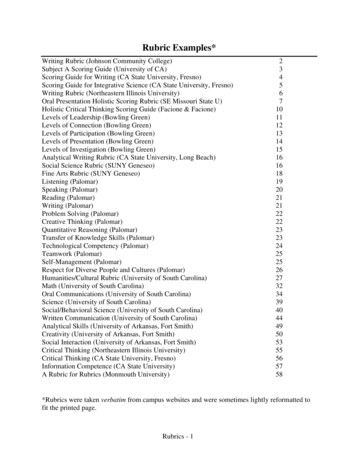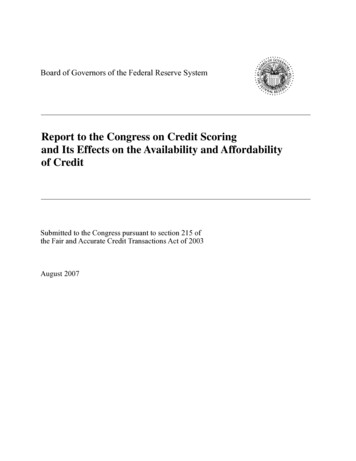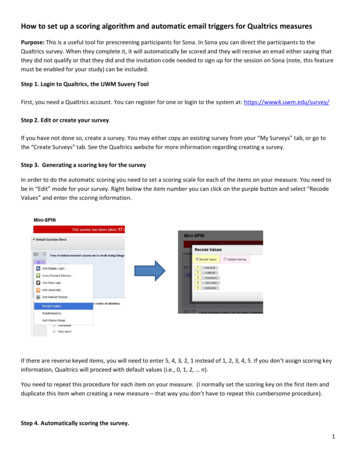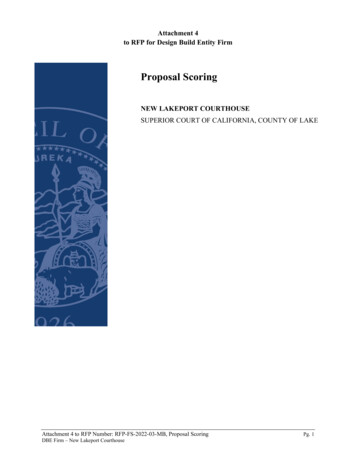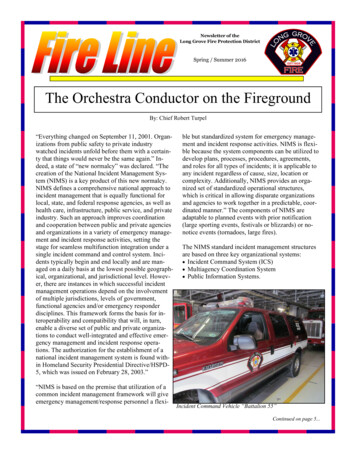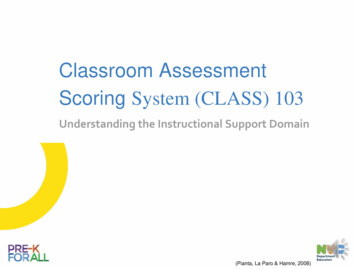
Transcription
Classroom AssessmentScoring System (CLASS) 103Understanding the Instructional Support Domain(Pianta, La Paro & Hamre, 2008)
CLASS Webinar Series-Scope & SequenceTitleDescriptionCLASS 101 Why the DECE uses the CLASS tool What the CLASS tool measures What to expect before, during, and after a CLASS assessment What resources are available to support youCLASS 102 How teacher-child interactions contribute to child outcomes What effective interactions look like in Emotional Support domain and Classroom Organizationdomain Strategies for improving interactions in the Regard for Student Perspectives and InstructionalLearning Formats dimensionsCLASS 103 Why Instructional Support is important What effective interactions look like in this domain Strategies for improving Concept Development, Quality of Feedback, and Language ModelingdimensionsCLASS 104 How to read and interpret your CLASS report How to use CLASS data and recommendations to inform pre-K program goals
CLASS 103- Objectives Understand why the Instructional Support Domain is important Discuss what effective interactions may look like in the ConceptDevelopment, Quality Feedback and Language Modellingdimensions. Discuss strategies for improving interactions in each of thesedimensions
ralMarkersPositive Climate,Negative Climate,Teacher Sensitivity,Regard for StudentPerspectivesEx: Positive ClimateRelationshipsPositive affectPositive CommunicationRespectEx: RelationshipsPhysical Proximity,Shared tBehavior Management,ProductivityInstructional LearningFormats.ConceptDevelopment,Quality of Feedback,Language ModelingEx: Behavior ManagementClear behavior expectationsProactiveRedirection of MisbehaviorStudent BehaviorEx: Clear BehaviorExpectationsConsistency, clarityofrulesEx: Concept DevelopmentAnalysis and ReasoningCreatingIntegrationConnections to the Real WorldEx: Analysis andReasoningWhy and/or howquestions,Integration(Pianta, La Paro & Hamre, 2008)
CLASS Dimensions GuideThroughout the presentation we will be referencing thePre-K CLASS Dimensions Guide
Instructional Support Domain
Instructional Support DomainHow staff Help children learn to solve problems, reason,and think Use feedback to expand and deepenskills, knowledge and performance Help children develop more complex language skills(Pianta, La Paro & Hamre, 2008)
Instructional Support Domain Three dimensions:ConceptDevelopmentQuality ofFeedbackLanguageModeling Aligns with EFQ: Advance play-based learningand responsive instruction (3)(Pianta, La Paro & Hamre, 2008)
Why is Instructional Supportimportant? Children develop many skills through their interactions withadults, including cognitive and language skills Provides a framework to identify the types of interactionsthat are associated with improved outcomes for children Research shows relationship between higher instructionalsupport scores and improved outcomes for children(Pianta, La Paro & Hamre, 2008)
Concept Development
Dimensions GuidePage 18 & 19
Concept DevelopmentMeasures staff’s use of instructional discussions andactivities to promote children’s higher-order thinkingskills and cognition and staff’s focus on understandingrather than on rote instruction(Pianta, La Paro & Hamre, 2008)
Analysis andReasoningWhat this looks like in a 3-k and pre-Kclassroom:Why and/or how questions “Why did the tower fall over?” “How do you know that blue is thenext color in the pattern?”Problem Solving “I notice this block structure keeps fallingover. What can we do to fix this?” “I see you both want to use the violetcrayon. What could we do to solvethis problem?”(Pianta, La Paro & Hamre, 2008)
Analysis andReasoningPrediction (Before reading a book, show the cover)“What do you think this book will be about?” “What would happen if I placed a cylindricalpiece on the roof of this block structure?” “Which car will make it down theramp first?”Classification/comparison “What do you notice about these blocksthat are similar/different?” “Can we sort these shapes into ones thathave curves and ones that have straightlines? “Evaluation “Tell me about what you did. Whatwould you do differently if you did itagain next time?” “How did you decide who would be thedoctor?” (in Dramatic Play)(Pianta, La Paro & Hamre, 2008)
Staff actively facilitate opportunities forchildren to be creative and guide them togenerate their own ideas and products.CreatingBrainstorming “What are some ways we could create arocket ship?” “What are some ways we could use theselemons?” “What are some animals you might see at thezoo?” “Oh, the baby is sick, what could we do tomake it feel better?"(Pianta, La Paro & Hamre, 2008)
CreatingPlanning “What are you going to make? What will youneed to make that? How will you create it?” “Oh, you want to build a fire station. What willyou need to make that?” You’re at the grocery store. What are you goingto sell? How much will those items cost?”Producing Staff supports the opportunity for childrento create and execute the plans they madetogether.(Pianta, La Paro & Hamre, 2008)
Integration For this indicator, we are looking for staff tomake clear and explicit connectionsbetween what children are doing and thingsthey have previously done or learned Staff make explicit attempts to tie togetherconcepts rather than simply mentioningconnections in passing and does this often Staff embed questions in a discussionthat help children understand what theymay already know about a subject, whichthen helps them best integrate theirexisting knowledge with new conceptsIntegrationNote:Having a clear theme that’svisually evident across theclassroom is not enough.Staff need to make explicitverbal connections betweenwhat a child is doing andtheir previous learning(Pianta, La Paro & Hamre, 2008)
IntegrationIntegration “Remember last week when we plantedseeds and took care of them till they grewinto a plant? What did we do to take care ofthem?”“Today we are going to learn about farms.On a farm farmers also plant lots of seedsand take care of them. What do you thinkfarmers have to do to take care of theseeds that they plant?” “That tower is tremendous! We’ve beenlearning about different ways to measure. Iwonder how we could measure how tall thisis?”(Pianta, La Paro & Hamre, 2008)
Connections to the real -world For this indicator, staff make consistent andintentional efforts to make learningmeaningful by helping children apply theirthinking to real- world events that are partof the children’s everyday experience insideand outside the classroom. (At Dramatic Play Area) “Oh, the baby iscrying, what are some things you’ve seenyour Mom do to calm down a fussy baby?” (Reading The Snowy Day) “It looks likePeter is really enjoying the snow. What aresome things you like to do in the snow?”Connections tothe real world(Pianta, La Paro & Hamre, 2008)
The Importance of Frequency, Depth and DurationFrequencyDepthDurationHow ofteninteractions occurredduring an observationcycleHowimpactful/powerfulthese interactionswere during anobservation cycleHow long interactionstook place during anobservation cycle(Pianta, La Paro & Hamre, 2008)
Indicator Ranges DetermineDimension ScoreAnalysis &ReasoningCreatingIntegrationConnectionsto the RealWorldConceptDevelopmentScore(Pianta, La Paro & Hamre, 2008)
Quality Feedback
Dimensions GuidePage 20 & 21
Quality of FeedbackAssesses the degree to which the staff provides feedbackthat expands learning and understanding andencourages continued participation(Pianta, La Paro & Hamre, 2008)
What this looks like in a 3-k and pre-K classroom:ScaffoldingA teacher acknowledges where a student is startingScaffoldingand provides the necessary level of help to allow thestudent to succeed or complete a task.Hints Helping children by providing hints andassistance but not doing it for themAssistance Noticing a child is struggling with his/her jacketand connecting the bottom so that they can zip itup Hand over hand support using scissors Helping a child identify a peer’s name on a chartby reminding them of the first sound in the name(Pianta, La Paro & Hamre, 2008)
Prompting Thought ProcessPromptingThoughtProcessAnother name for this might be “explain yourthinking” (After a child builds a block structure) “Whydid you put that triangular piece on the top?” “I noticed that you painted this portion red.Why did you do that?” “You said this is a zebra. Tell me why youthink this is a zebra.”(Pianta, La Paro & Hamre, 2008)
Providing informationStaff go beyond saying something is correct or incorrect.Staff respond to children’s comments or actions byexpanding upon them and providing additional informationProvidinginformation During a small-group lesson sorting fruit, a student putsa banana in the fruit bin. The teacher then says, “Ah, Isee you put the banana in the fruit bin. You’re right, thebanana is a fruit just like an orange and a pear becausethey are sweet and fleshy (Expansion) A child might say, “A tomato is a fruit and you cannotput it in a salad.” The teacher then clarifies the partiallyincorrect answer and says, “A tomato is a fruit, but youcan have it in salads.”(Clarification) During a gardening activity, a child overflowed the potwith water.Teacher: “That’s a lot of water! Next time, we will put alittle bit less because if it’s too wet, then the seed willnot be able to grow.”(Specific Feedback)(Pianta, La Paro & Hamre, 2008)
Encouragement and AffirmationEncouragementand affirmationStaff offer specific encouragement andaffirmation that increases a child'sunderstanding, involvement, effort, persistenceor trying new strategies. “You’ve been working really hard on writingyour name.” (Recognition) “What a fantastic drawing! Look at all of thedifferent colors you’ve mixed in, I’ll bet youcan do another.” (Reinforcement) “That looks hard. Keep going because Ithink you can do it!” (Student Persistence)(Pianta, La Paro & Hamre, 2008)
Feedback loopsFeedbackLoops Feedback loops are back and forthexchanges that help children reach ahigher level of understanding Usually integrates the other indicators(Pianta, La Paro & Hamre, 2008)
Feedback Loop ExampleA child and a teacher are talking about dinosaursStaff: Is this a plant eater or a meat eater?Child: A meat eater!Staff: Why do you think it is a meat eater?Child: It’s really big!Staff: Are all dinosaurs that are really big meat eaters?Child: YesStaff: But the Titanosaurus is the biggest dinosaur. Is it a meat eater?Child: No. It ate plantsStaff: So how can we tell if it eats meat?Child: Ummm. . .Staff: Let’s look at our chart. What do all the meat eaters have in common?Child: Ummm. . .Staff: Think about what they use to catch and eat other dinosaurs.Child: Sharp teeth and claws!Staff: You thought really hard about that! Yes, we can usually tell if a dinosaur iscarnivorous by looking at its teeth and claws.(Pianta, La Paro & Hamre, 2008)
Feedback Loop ExampleA child and a teacher are talking about dinosaursStaff: Is this a plant eater or a meat eater?Child: A meat eater!Staff: Why do you think it is a meat eater? (Prompting Thought Process)Child: It’s really big!Staff: Are all dinosaurs that are really big meat eaters?Child: YesStaff: But the Titanosaurus is the biggest dinosaur. Is it a meat eater? (ProvidingInformation)Child: No. It ate plantsStaff: So how can we tell if it eats meat?Child: Ummm. . .Staff: Let’s look at our chart. What do all the meat eaters have in common? (Scaffolding)Child: Ummm. . .Staff: Think about what they use to catch and eat other dinosaurs (Scaffolding)Child: Sharp teeth and claws!Staff: You thought really hard about that! (Encouragement and Affirmation)Yes, we can usually tell if a dinosaur is carnivorous by looking at its teeth and claws.(Providing Information)(Pianta, La Paro & Hamre, 2008)
Language Modeling
Dimensions GuidePage 22 & 23
Language ModelingCaptures the effectiveness and amount of the staff’s useof language stimulation and language facilitationtechniques(Pianta, La Paro & Hamre, 2008)
FrequentconversationWhat this looks like in a 3-k and pre-Kclassroom:Frequent Conversation Many conversations occur between childrenand staff and among children that promoteopportunities for language use Staff often initiate conversations withchildren; in addition, there is a natural flow inthe exchange of information during centertime or other periods of time thatencourages children to converse and makesthem feels as if they are valuedconversational partners Conversations are engaging for childrenbecause staff actively listen, contributerelevant responses, and ask related questions Children also engage in conversations witheach other(Pianta, La Paro & Hamre, 2008)
Open -ended questionsOpen-endedquestions Open-ended questions are those that inviteelaborate responses, such as “Tell meabout .” or “Share your story with thegroup.” Often, these are questions which theanswer is unknown, such as “Why do youthink?” or “How do you know?” The important consideration for thisdimension is that staff asks open-endedquestions that require children to puttogether language to communicate morecomplex ideas(Pianta, La Paro & Hamre, 2008)
Repetition or ExtensionStaff often repeat or extend the children's responsesRepetitionandExtensionUsing Repetition:Child: It’s a box [pointing to a box they are painting]Teacher: Oh, you’re painting the blue boxChild: Car is fastTeacher: Yes, your car is going very fast.Child: That her dollyTeacher: That is her dolly!(Pianta, La Paro & Hamre, 2008)
Repetition or ExtensionStaff often repeat or extend the children's responsesRepetitionandExtensionUsing Extension:Child: It’s a box [pointing to a box they are painting]Teacher: Oh, you’re painting the blue box. It’s agood box for your toysChild: Car is fastTeacher: Yes, your car is going very fast. It’scoming around the cornerChild: That her dollyTeacher: Yes, that is Miya’s dolly. She looks like sheis hungry.(Pianta, La Paro & Hamre, 2008)
Self and Parallel TalkSelf- andparallel talkSelf-talk Staff narrates their own actionswith language as they happenParallel talk Staff narrates a child’s actions with languageas they happen(Pianta, La Paro & Hamre, 2008)
Advanced languageStaff often use advance language with childrenAdvancedlanguageVariety of words Staff use a variety of nouns, verbs, adverbs ,adjectives and prepositions, and otherforms of language that are new to thechildren. Consider the following example:Teacher: Tell me about your hatChild: Red. Orange. Yellow. Green. Blue.Teacher: You have different colors in your hat.It is a multicolored hat.(Pianta, La Paro & Hamre, 2008)
Advanced languageAdvancedlanguageConnecting new or unfamiliar words toeveryday objects a child is familiar with Providing child-level definitionsconnected to things they knowTeacher: (reading from a book) “It’s time to sealyour shell and sleep.” What is she going to do ifshe seals her shell?Child: Get inside her shellTeacher: That’s right. Just like how we seal aplastic bag. You know how to do that. She isgoing to seal her shell nice and tight so thatnothing can get in and nothing can get out.She will stay nice and warm.(Pianta, La Paro & Hamre, 2008)
Instructional Support Domain Three dimensions:ConceptDevelopmentQuality ofFeedbackLanguageModeling(Pianta, La Paro & Hamre, 2008)
Additional Resources– Instructional SupportTeacher Tips: Asking Open-Ended QuestionsAnalysis and Reasoning Prompts for CentersImproving Instructional Support Strategies at theWater Table – And Beyond!Understanding Integration in Concept DevelopmentThe Difference Between Concept Development andQuality of Feedback – and Why It MattersTeacher Tips: Making Real-World Connections Come Alive atStory Time
Additional Resources– GeneralOther CLASS webinars, trainings and useful resourceshttp://bit.ly/NYCProgramAssessmentCLASS Dimensions GuideTeachstone resource pagehttp://teachstone.com/resources/Questions? Email: programassessment@schools.nyc.gov
Thank you!
Classroom Assessment Scoring System (CLASS) 103 . Understanding the Instructional Support Domain (Pianta, La Paro & Hamre, 2008) CLASS Webinar Series-Scope & Sequence . Why the DECE uses the CLASS tool What the CLASS tool measures What to expect before, during, and after a CLASS assessment What resources are available to .

